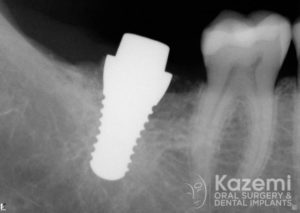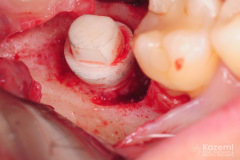Dental implant removal may be the only treatment option in cases of moderate to advanced peri-implantitis, significant infection, poor alignment, or fractures of involved implants. In such cases, reverse torque explantation (implant removal) is the technique of choice allowing atraumatic removal of the implant without incision or bone removal. While reverse torque explantation works remarkably well for removal of Titanium dental implants, it is less effective in removal of 2-piece (separate implant and abutment) Zirconia (ceramic) dental implants. This is due to likelihood fracture of the ceramic implant under high compressive forces exerted during reverse torque. In the second type of Zirconia implants where the implant and abutment are connected as a single piece, the explantation technique is simply not an option as the torque device can not engage the internal aspect of the implant.
 Removal of an ailing or failing 1-piece Zirconia dental implant is best performed using an ultrasonic bone instrument known as Piezo. Conventional cutting instruments require excessive bone removal and lead to large defects whereas a Piezo with fine tips can help remove the implant with minimal insult to the supporting bone. Lets look at an example:
Removal of an ailing or failing 1-piece Zirconia dental implant is best performed using an ultrasonic bone instrument known as Piezo. Conventional cutting instruments require excessive bone removal and lead to large defects whereas a Piezo with fine tips can help remove the implant with minimal insult to the supporting bone. Lets look at an example:
This patient presented with chronic pain around her lower Zirconia dental implant. The implant had developed deep inflammatory pockets consistent with advanced peri-implantitis. Earlier attempts at ‘cleaning’ the implant was unsuccessful. Removal of the implant was recommended due to advanced tissue loss and continued symptoms.


The implant was a 1-piece Zirconia fixture with a wide platform at the top. First, lets look at each implant removal technique and discuss why it would not work!
- Reverse torque technique using a special explantation device for removal is not an option due to lack of central channel where the torque device would need to engage.
- The implant wrench / device used to place the implant initially in reverse mode would likely result in either implant fracture or stripping of head of the implant abutment. This technique would only work if the entire implant has lost its integration with the bone.
- Conventional cutting trough burs would require a significant removal of bone and lead to a large bony defect. This is particularly significant on this implant design with a wide platform on the top. An extra wide cutting bur would be required to fit over the platform, but then it would result in 3-4 mm of bone removal around the implant. This would effectively destroy the jaw bone all around the implant.
A Piezo with fine tips to remove 0.5-1 mm of bone around the implant is the ideal approach for removal of such implant. The implant was successfully removed with minimal residual bony defect. The site was cleaned and grafted with bone and Platelet Rich Fibrin.

Piezoelectric is the preferred technique for removal of 1-piece Zirconia dental implants and 2-piece Zirconia dental implants where a reverse torque method was not successful. It is considered significantly less invasive than conventional bone cutting trough burs and allows for a faster and less painful patient recovery.

Dr. H. Ryan Kazemi is a board-certified oral and maxillofacial surgery in Bethesda, MD







